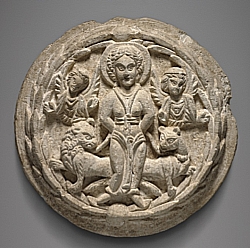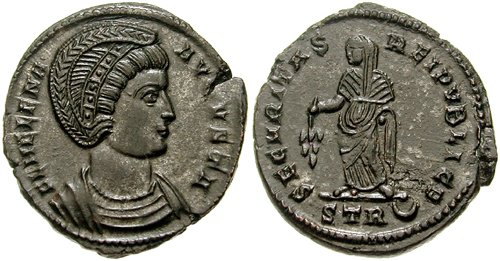by VK McCarty, General Theological Seminary, NY

One of the rather thrilling aspects of crafting this new book—From Their Lips: Voices of the Early Christian Women—has been the sense of embodying women glimpsed in historical artworks and ancient texts; and bringing them to life, making them accessible to readers in the book. Encountering these brave women and studying them has stirred a commitment in me to help fill the gap left by telling the story of Church History and Early Christianity and often leaving out half the faithful—the women.
For example, I met the Early Christian saint, Thecla, in a stunning fifth-century Egyptian relief sculpture from which it was hard to look away. A likely companion of the Apostle Paul, she stands before us praying, yet stripped and bound, and provocatively exposed to public view in the arena in Antioch. This limestone roundel, possibly from nearby Oxyrynchus, captures in high relief the moment when divine intervention is about to transform an intense scene of violation and potential death with a promise of the salvation in times of strife for early believers.
The nude figure in the twenty-five inch carving is surrounded by rampant threatening lions, but divinely protected by angels. She is covered in only a prisoner’s loin-cloth, the aura of a saint’s halo surrounding her face and nobly braided hair. Additionally, what contemporary viewers may miss, but fifth-century viewers knew well, was that the woman depicted was about to be drawn and quartered. The harness-style straps stretched across her breasts bind her hands behind her back; the young Christian is also tied by her feet to “two fearful bulls” (4.10). Reflecting his own sexual frustration, Thekla’s attacker, the bellicose Syrian council leader Alexander, has bragged that he will torture the beasts with red-hot irons pressed to their private parts, enraging them to run in opposite directions and tear Thecla apart. But at the very moment of violent pandemonium, God intervenes and saves the newly baptized convert to faith with a cloud of fire.
Thekla’s deliverance from martyrdom and her subsequent preaching ministry captured the imagination of countless Christians in the early centuries of the Jesus movement. Her story is known to us from the Acts of Paul and Thecla; one of the apocryphal documents circulating alongside the authorized books of scripture in the late second century, when the New Testament canon was still in the process of being formally codified. This, and the Acts of Paul, of which it became a part, is attested in Greek, Latin, and Syriac versions, among others. Even if Thekla’s account is deemed extracanonical, it may nevertheless reflect remarkably accurately the experience of many second-century women who ventured away from the family hearth to follow the Gospel taught by Paul and found themselves, like Thekla, in violent confrontation with society. The Acts of Paul and Thecla is a tale of high adventure and divine miracles, and it presents a vibrant tension living between the ascetic and erotic components of the story.
The example of Thekla was used as an endorsement in support of women’s active ministry in the Early Church, including preaching and baptizing, as can be seen by Church Father Tertullian black-listing her in De Baptismo 17. Thecla’s luminous faith and her reported confrontations speaking up to Paul accompany me on my own encounters negotiating ministry, especially when the foundation of my faith is challenged by the prevailing hierarchy of authority.

November, 2009.
The Dowager Empress, Helena Augusta, mother of the Emperor Constantine I and sister in faith of St. Thecla, is a figure who witnesses in my life, bringing strength and clarity in times when my courage wavers. Seeing evidence of her ambitious life in Roman coins made me curious what we could actually know about her beyond her legendary reputation associated with finding the True Cross. In fact, Imperial coinage provides a fascinating window into the changing world of Roman governance and royal favor—and offers an enduring glimpse of St. Helena in history. When empresses appear on coins, they are always historically meaningful.
In an age before cinema and news journalism, imperial coinage served a vital function; not only economically, but also as official state communication. Learning how to read Roman coins helps to contextualize the social and ethical environment of any generation of the ruling Roman families. Roman coins have verified fascinating historical details about Helena in a relatively durable medium. While the minting process produced only crude facial features, familiar and recognizable elements of faces were nevertheless carefully incorporated into the crafted product, such as Helena’s long sharp, slightly hooked Constantinian nose on the coin shown above.
Indeed, for the majority of the empire at the time, one of the most significant means of communication about the likeness and rising status of Helena were the state issues of coinage. In fact, at times her imperial face counted for as much as twenty percent of the issue. The Latin text on the front faces of Roman coins—the obverse—was an official state document, and it was distributed, imperishable, to the ends of the world and minted in gold and bronze.
The coin portrait of Helena in the plate above is remarkable for its precision in detail, particularly in illustrating elements of Helena’s royal toilette. The empress is appareled in the mantle typical of Roman court dress, in a bust facing right, with her head prominently positioned so that no words rise above it, which honors her in the “broken legend” style. This empty space above the head in imperial Roman coins mirrored one of the concepts of kingship: nothing man-made was to stand between the imperial head and the gods in heaven above. While Helena was alive, Constantine bestowed on her the “broken legend”; but after her death, he issued it only for himself.
Empress Helena wears a distinctly ladder-shaped crown running across the forehead, signifying her senior imperial rank, and decorated with dots indicating pearls. Christian empresses in the Byzantine era after Helena developed even more elaborate diadems, embellished with strands of pearl pendillia draped from the ears.
Helena’s hair is drawn back and fashioned into a prominent braid, probably assisted by ropes of pearls which are visible on the coin, and swept up the back of the head to form a distinctive crest-like feature on the top; one which, in the coin shown, covers the diadem. Although this hair-style was worn by earlier empresses, it came to be named after Empress Magnia Urbica, wife of Emperor Carus. An interesting question arises around the precedence of the two royal ladies at court with Emperor Constantine—who comes first: Helena or the Emperor’s wife?—but the evidence of Roman coin portraits showing Helena with a diadem and the Empress Fausta as bare-headed demonstrate a distinction of rank despite their identical imperial titles. Thus, Helena is thought to have ranked higher than her daughter-in-law.
In enjoying viewing this coin, it is satisfying to know that, even with the embellished tapestry of legends about Helena, some unique strength must have been remembered as hers alone, some persistent thread of admirable character which captured the hearts of people around her; and in the same way, there is surely a golden thread of reality which is shot through the fabric of her legend and still describes the actual Helena today.

VK McCarty is the author of From Their Lips: Voices of Early Christian Women (Gorgias, 2021); she writes and lectures about Ascetical Theology at General Theological Seminary and is published by The Institute for Studies in Eastern Christinity, the International Congregational Journal and Public Orthodoxy.
Get 30% off when you order From Their Lips: Voices of the Early Christian Women from the Gorgias Press website with coupon code VK30%
Orders must be placed via www.gorgiaspress.com before July 30 to qualify for the discount.
